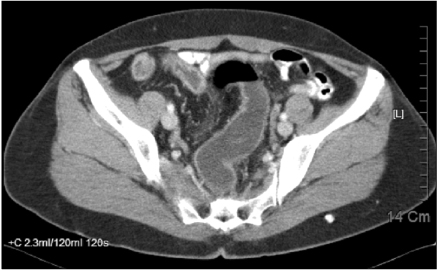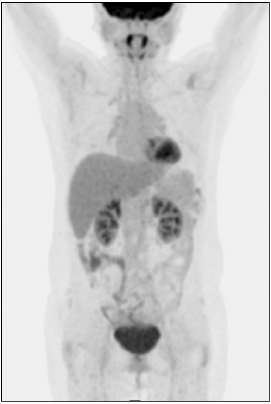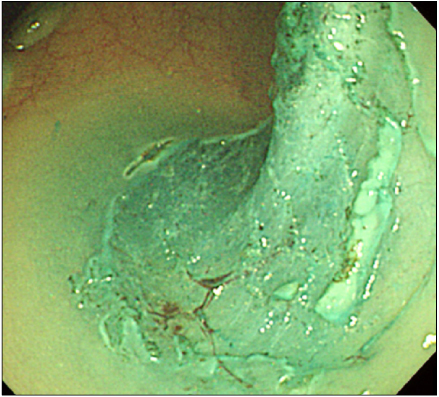Ewha Med J.
2012 Mar;35(1):44-48. 10.12771/emj.2012.35.1.44.
Sessile Serrated Adenoma with High-grade Dysplasia
- Affiliations
-
- 1Department of Internal Medicine, Ewha Womans University School of Medicine, Seoul, Korea. jassa@ewha.ac.kr
- KMID: 2134945
- DOI: http://doi.org/10.12771/emj.2012.35.1.44
Abstract
- Until recently, colorectal polyps were classified predominantly as hyperplastic or adenomatous. While adenomatous polyps are well-characterized precursor lesions of adenocarcinomas, hyperplastic polyps have been considered as benign lesion. However, some hyperplastic polyps with serrated morphology of the crypts have been recognized to have distinctive features and these polyps were termed 'serrated adenomas'. Recent data show that sessile serrated adenomas (SSA) might be the precursors of serrated colonic cancers, underlining the necessity of identifying them. SSA is approximately 3% of all polyps, commonly appears as flat or sessile and yellowish due to mucus production. In the pathogenesis of SSA, progression to high grade dysplasia or early invasive carcinoma may be associated with serrated neoplasia pathway different from adenoma-carcinoma sequence. We report a case with a colon polyp diagnosed as sessile serrated adenoma with high grade dysplasia after endoscopic submucosal dissection.
Figure
Reference
-
1. Longacre TA, Fenoglio-Preiser CM. Mixed hyperplastic adenomatous polyps/serrated adenomas: a distinct form of colorectal neoplasia. Am J Surg Pathol. 1990. 14:524–537.2. Fenoglio CM, Pascal RR. Colorectal adenomas and cancer: pathologic relationships. Cancer. 1982. 50:2601–2608.3. Makinen MJ, George SM, Jernvall P, Makela J, Vihko P, Karttunen TJ. Colorectal carcinoma associated with serrated adenoma: prevalence, histological features, and prognosis. J Pathol. 2001. 193:286–294.4. Aust DE, Baretton GB. Serrated polyps of the colon and rectum (hyperplastic polyps, sessile serrated adenomas, traditional serrated adenomas, and mixed polyps)-proposal for diagnostic criteria. Virchows Arch. 2010. 457:291–297.5. Torlakovic E, Snover DC. Serrated adenomatous polyposis in humans. Gastroenterology. 1996. 110:748–755.6. Goldstein NS, Bhanot P, Odish E, Hunter S. Hyperplastic-like colon polyps that preceded microsatellite-unstable adenocarcinomas. Am J Clin Pathol. 2003. 119:778–796.7. Leggett B, Whitehall V. Role of the serrated pathway in colorectal cancer pathogenesis. Gastroenterology. 2010. 138:2088–2100.8. Snover DC. Update on the serrated pathway to colorectal carcinoma. Hum Pathol. 2011. 42:1–10.9. Leggett BA, Devereaux B, Biden K, Searle J, Young J, Jass J. Hyperplastic polyposis: association with colorectal cancer. Am J Surg Pathol. 2001. 25:177–184.10. Vogelstein B, Fearon ER, Hamilton SR, Kern SE, Preisinger AC, Leppert M, et al. Genetic alterations during colorectal-tumor development. N Engl J Med. 1988. 319:525–532.11. Chan TL, Zhao W, Leung SY, Yuen ST. BRAF and KRAS mutations in colorectal hyperplastic polyps and serrated adenomas. Cancer Res. 2003. 63:4878–4881.12. Koinuma K, Shitoh K, Miyakura Y, Furukawa T, Yamashita Y, Ota J, et al. Mutations of BRAF are associated with extensive hMLH1 promoter methylation in sporadic colorectal carcinomas. Int J Cancer. 2004. 108:237–242.13. Iino H, Jass JR, Simms LA, Young J, Leggett B, Ajioka Y, et al. DNA microsatellite instability in hyperplastic polyps, serrated adenomas, and mixed polyps: a mild mutator pathway for colorectal cancer? J Clin Pathol. 1999. 52:5–9.14. Jass JR. Hyperplastic-like polyps as precursors of microsatellite-unstable colorectal cancer. Am J Clin Pathol. 2003. 119:773–775.15. Torlakovic E, Skovlund E, Snover DC, Torlakovic G, Nesland JM. Morphologic reappraisal of serrated colorectal polyps. Am J Surg Pathol. 2003. 27:65–81.16. Sheridan TB, Fenton H, Lewin MR, Burkart AL, Iacobuzio-Donahue CA, Frankel WL, et al. Sessile serrated adenomas with low- and high-grade dysplasia and early carcinomas: an immunohistochemical study of serrated lesions "caught in the act". Am J Clin Pathol. 2006. 126:564–571.17. Gurudu SR, Heigh RI, De Petris G, Heigh EG, Leighton JA, Pasha SF, et al. Sessile serrated adenomas: demographic, endoscopic and pathological characteristics. World J Gastroenterol. 2010. 16:3402–3405.18. Lu FI, van Niekerk de W, Owen D, Tha SP, Turbin DA, Webber DL. Longitudinal outcome study of sessile serrated adenomas of the colorectum: an increased risk for subsequent right-sided colorectal carcinoma. Am J Surg Pathol. 2010. 34:927–934.19. Snover DC. Serrated polyps of the large intestine. Semin Diagn Pathol. 2005. 22:301–308.20. Snover DC, Jass JR, Fenoglio-Preiser C, Batts KP. Serrated polyps of the large intestine: a morphologic and molecular review of an evolving concept. Am J Clin Pathol. 2005. 124:380–391.21. Bauer VP, Papaconstantinou HT. Management of serrated adenomas and hyperplastic polyps. Clin Colon Rectal Surg. 2008. 21:273–279.22. Noffsinger AE. Serrated polyps and colorectal cancer: new pathway to malignancy. Annu Rev Pathol. 2009. 4:343–364.23. Winawer SJ, Zauber AG, Fletcher RH, Stillman JS, OBrien MJ, Levin B, et al. Guidelines for colonoscopy surveillance after polypectomy: a consensus update by the US Multi-Society Task Force on Colorectal Cancer and the American Cancer Society. Gastroenterology. 2006. 130:1872–1885.24. Rex DK, Kahi CJ, Levin B, Smith RA, Bond JH, Brooks D, et al. Guidelines for colonoscopy surveillance after cancer resection: a consensus update by the American Cancer Society and US Multi-Society Task Force on Colorectal Cancer. CA Cancer J Clin. 2006. 56:160–167.
- Full Text Links
- Actions
-
Cited
- CITED
-
- Close
- Share
- Similar articles
-
- Strategy for post-polypectomy colonoscopy surveillance: focus on the revised Korean guidelines
- Characteristics and outcomes of endoscopically resected colorectal cancers that arose from sessile serrated adenomas and traditional serrated adenomas
- Evolving pathologic concepts of serrated lesions of the colorectum
- Korean Guidelines for Postpolypectomy Colonoscopic Surveillance: 2022 Revision
- Sessile Serrated Adenomas: How to Detect, Characterize and Resect






